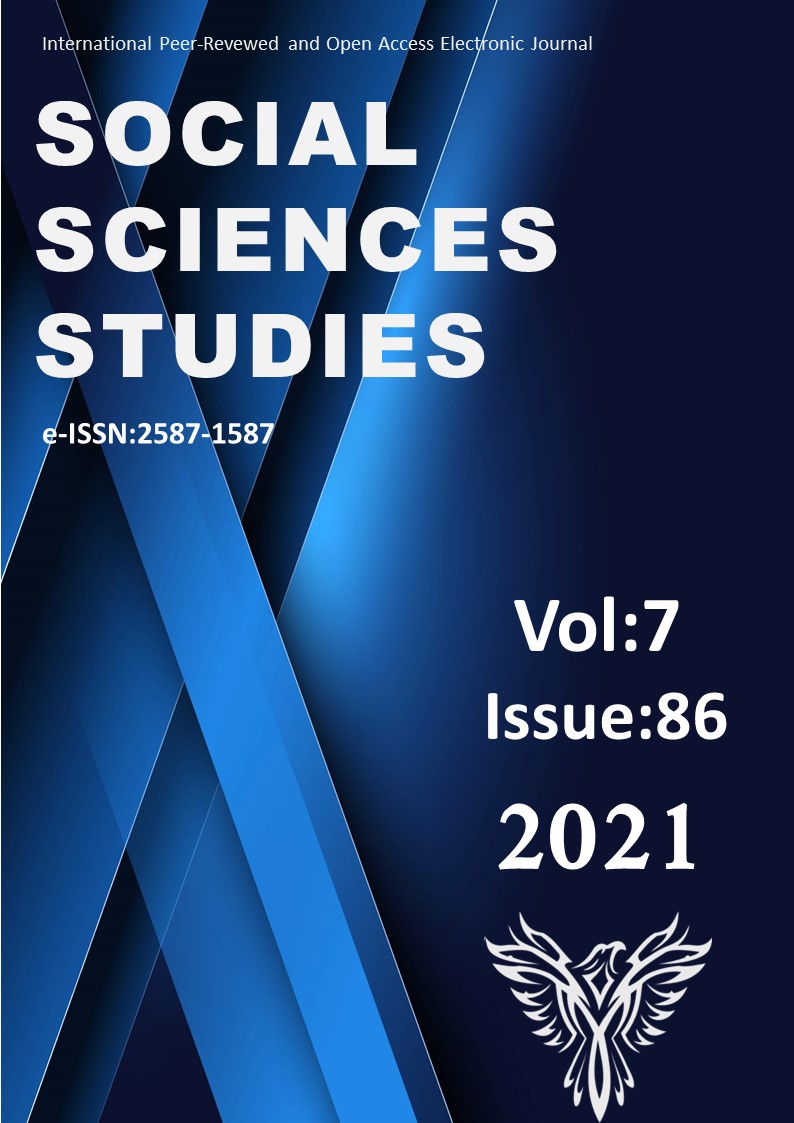Author :
Abstract
Amaç: İçinde bulunduğumuz dönemde, okul ortamında ve çevresinde zorbaca davranışlar, söylemler ve eylemler azımsanmayacak düzeydedir. Akran zorbalığı, öğrencilerin temel insan hakları olan güvende olma ve eğitim almasına, eğitim kurumlarının ise temel görevlerinden olan fiziksel ve ruhsal olarak sağlıklı bireyler yetiştirmesine engel teşkil etmektedir. Bu araştırmanın amacı, ortaöğretimde akran zorbalığını, zorba/kurban olmayı etkileyen kişisel ve çevresel unsurlar yönüyle araştırmak, zorba/kurban olma arasındaki ilişkiyi incelemektir. Yöntem: Araştırma, 2020-2021 öğretim yılında Milli Eğitim Bakanlığı’na bağlı genel eğitim veren resmi ortaokullarda eğitim gören öğrencilerle gerçekleştirilmiştir. Veri toplama için araştırmacılar tarafından oluşturulan sosyo-demografik özellikleri içeren “Kişisel Bilgi Formu” ve “Akran Zorbalığı Belirleme Ölçeği Ergen Formu” kullanılmıştır. Bulgular: Çalışmanın sonuçlarına göre, Akran Zorbalığını Belirleme Ölçeği alt boyutları, öğrencilerin cinsiyetlerine ve devam etmekte oldukları okula göre farklılık gösterirken, yaş grupları, kardeş sayısı, anne-baba eğitim durumu, aile gelir düzeyi algısı ve okul başarı algısına göre farklılık göstermemektedir. Ayrıca Akran Zorbalığı Ölçeği Zorba Olma Boyutu ile Kurban Olma Boyutu arasında orta kuvvete pozitif yönlü bir ilişki saptanmıştır. Bu durum zorba ve kurban olma arasındaki kısırdöngüyü işaret etmektedir. Sonuç: Bu araştırmadan elde edilen bulgular ve ilgili literatür bilgileri ışığında; akran zorbalığı olgusunun kişisel, ailevi ve çevresel değişkenlerle farklı düzeylerde ilişkili olabileceği belirtilebilir. Öğrenci, öğretmen ve ebeveynler kapsamında nicel verilerin yanı sıra nitel verileri de içeren karma yöntem çalışmaları yapılabilir. Özellikle şiddetin döngüselliğine ilişkin daha derinlemesine çalışmalara ihtiyaç vardır. Ayrıca her bölgeye özel olarak geliştirilecek koruyucu önleyici çalışmalar; eğitim ve psikososyal destek ortamları, sosyal medyanın da etkin kullanımı ile geliştirilecek bilinçlendirme programlarının etkin ve yararlı olacağı öngörülmektedir.
Keywords
Abstract
Objective: Bullying behaviors, words and actions in and around the school environment are currently at a considerable level. Peer bullying prevents students from experiencing their basic human rights of being safe and receiving education, while it prevents educational institutions from providing their basic duty of raising physically and mentally healthy individuals. The aim of this research is to investigate peer bullying in secondary education in terms of personal and environmental factors that affect bullying/victimization, and to examine the relationship between bullying and victimization. Method: The research was carried out with students studying in public secondary schools that provide education under the Ministry of Education, in the 2020-2021 academic year. For data collection, "Personal Information Form" and "Peer Bullying Scale Adolescent Form", which include socio-demographic characteristics created by the researchers, were employed. Findings: Results of the study indicate that the sub-dimensions of the Peer Bullying Scale differ in terms of the gender of the students and the schools they attend, whereas the results do not differ in terms of age groups, number of siblings, education level of parents, perceived family income, and perceived school success. In addition, a moderately strong positive correlation was found between the Bullying Dimension and the Victimization Dimension of the Peer Bullying Scale, which implies a vicious circle between being a bully and being a victim. Conclusion: In the light of the findings of this study and the relevant literature, it can be stated that the phenomenon of peer bullying can be related to personal, familial and environmental factors, each contributing at at different levels. Mixed method studies with qualitative as well as quantitative data could be carried out, covering students, teachers, and parents. In particular, more in-depth studies on the cyclicity of violence are needed. Also, it is envisaged that existence of educational and psychosocial support units, protective-preventive studies that will be developed specifically for each region, and awareness-raising programs effectively benefiting from social media will be effective and useful.
Keywords
- Baş, E. & Özeren, G.S. (2021). “Ortaöğretimde Akran Zorbalığı, Zorba/Mağdur Olmayı Etkileyen Kişisel Ve Çevresel Unsurlar”
- International Social Sciences Studies Journal, (e-ISSN:2587-1587) Vol:7, Issue:86; pp:3419-3430 ORTAÖĞRETİMDE AKRAN ZORBALIĞI, ZORBA/MAĞDUR OLMAYI ETKİLEYEN KİŞİSEL ve ÇEVRESEL UNSURLAR Peer Bullying In Secondary Education, Personal And Environmental Factors Affecting Being Bully/Victim Emin BAŞ Öğretmen, Milli Eğitim Bakanlığı, Kozluk Ortaokulu, Samsun/TÜRKİYE Dr. Öğr. Üyesi. Gül Sultan ÖZEREN Sinop Üniversitesi, Sağlık Bilimleri Fakültesi, Sinop/TÜRKİYE ÖZET Amaç: İçinde bulunduğumuz dönemde, okul ortamında ve çevresinde zorbaca davranışlar, söylemler ve eylemler azımsanmayacak düzeydedir. Akran zorbalığı, öğrencilerin temel insan hakları olan güvende olma ve eğitim almasına, eğitim kurumlarının ise temel görevlerinden olan fiziksel ve ruhsal olarak sağlıklı bireyler yetiştirmesine engel teşkil etmektedir. Bu araştırmanın amacı, ortaöğretimde akran zorbalığını, zorba/kurban olmayı etkileyen kişisel ve çevresel unsurlar yönüyle araştırmak, zorba/kurban olma arasındaki ilişkiyi incelemektir. Yöntem: Araştırma, 2020-2021 öğretim yılında Milli Eğitim Bakanlığı’na bağlı genel eğitim veren resmi ortaokullarda eğitim gören öğrencilerle gerçekleştirilmiştir. Veri toplama için araştırmacılar tarafından oluşturulan sosyo-demografik özellikleri içeren “Kişisel Bilgi Formu” ve “Akran Zorbalığı Belirleme Ölçeği Ergen Formu” kullanılmıştır. Bulgular: Çalışmanın sonuçlarına göre, Akran Zorbalığını Belirleme Ölçeği alt boyutları, öğrencilerin cinsiyetlerine ve devam etmekte oldukları okula göre farklılık gösterirken, yaş grupları, kardeş sayısı, anne-baba eğitim durumu, aile gelir düzeyi algısı ve okul başarı algısına göre farklılık göstermemektedir. Ayrıca Akran Zorbalığı Ölçeği Zorba Olma Boyutu ile Kurban Olma Boyutu arasında orta kuvvete pozitif yönlü bir ilişki saptanmıştır. Bu durum zorba ve kurban olma arasındaki kısırdöngüyü işaret etmektedir. Sonuç: Bu araştırmadan elde edilen bulgular ve ilgili literatür bilgileri ışığında; akran zorbalığı olgusunun kişisel, ailevi ve çevresel değişkenlerle farklı düzeylerde ilişkili olabileceği belirtilebilir. Öğrenci, öğretmen ve ebeveynler kapsamında nicel verilerin yanı sıra nitel verileri de içeren karma yöntem çalışmaları yapılabilir. Özellikle şiddetin döngüselliğine ilişkin daha derinlemesine çalışmalara ihtiyaç vardır. Ayrıca her bölgeye özel olarak geliştirilecek koruyucu önleyici çalışmalar; eğitim ve psikososyal destek ortamları, sosyal medyanın da etkin kullanımı ile geliştirilecek bilinçlendirme programlarının etkin ve yararlı olacağı öngörülmektedir. Anahtar Kelimeler: zorbalık, akran zorbalığı, şiddet, ortaöğretim, okullarda akran zorbalığı. ABSTRACT
